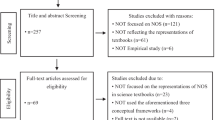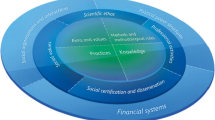Abstract
Reconceptualized Family Resemblance Approach to Nature of Science (RFN) explains science as a cognitive, epistemic, and social institutional system. The aim of this study is to examine the inclusion of Nature of Science (NOS) in the 5th, 6th, 7th, and 8th grade Turkish middle school science textbooks. The “content,” “activity,” and “assessment” sections of each science textbook were traced based on RFN categories which are “aims and values (AV),” “scientific practices (SP),” “methods and methodological rules (M),” “scientific knowledge (SK),” and “social institutional systems (SI)” through content analysis. As a result, the total frequency value of the codes regarding RFN categories was found to be 196 in the 5th grade, 548 in the 6th grade, 284 in the 7th grade, and 427 in the 8th grade science textbooks. Most references to NOS were found in the “activity” sections of the textbooks. Although there are some references to NOS in each textbook, some of the RFN categories in the whole textbooks are missing. Furthermore, a consistent progression for the frequency of NOS related keywords was not found throughout the grade levels. In conclusion, there is a need to integrate NOS into science textbooks holistically and in a balanced way to provide a vertical articulation throughout the grade levels.


Similar content being viewed by others
References
Abd-El-Khalick, F., Bell, R. L., & Lederman, N. G. (1998). The nature of science and instructional practice: Making the unnatural natural. Science Education, 82, 417–436.
Abd-El-Khalick, F. (2002). Images of nature of science in middle grade science trade books. New Advocate, 15(2), 121–127.
Abd-El-Khalick, F., Myers, J. Y., Summers, R., Brunner, J., Waight, N., Wahbeh, N., … & Belarmino, J. (2017). A longitudinal analysis of the extent and manner of representations of nature of science in US high school biology and physics textbooks. Journal of Research in Science Teaching, 54(1), 82-120.
Abd-El-Khalick, F. (2012). Nature of science in science education: Toward a coherent framework for synergistic research and development. In B. J. Fraser, K. Tobin, & C. McRobbie (Eds.), Second international handbook of science education, 2, (pp. 1041–1060). Springer
Abd-El-Khalick, F., Waters, M., & Le, A. P. (2008). Representations of nature of science in high school chemistry textbooks over the past four decades. Journal of Research in Science Teaching, 45(7), 835–855.
Allchin, D. (2011). Evaluating knowledge of (whole) science. Science Education, 95(3), 518–542.
American Association for the Advancement of Science [AAAS]. (1990). Science for allAmericans. Oxford University Press.
American Association for the Advancement of Science [AAAS]. (2009). Benchmarks for Science Literacy. Project 2061. Retrieved July 28, 2022, from http://www.project2061.org/publications/bsl/online/index.php?
Aydin, S., & Tortumlu, S. (2015). The analysis of the changes in integration of nature of science into Turkish high school chemistry textbooks: Is there any development? Chemistry Education Research and Practice, 16(4), 786–796.
BouJaoude, S., Dagher, Z. R., & Refai, S. (2017). The portrayal of nature of science in Lebanese ninth grade science textbooks. In C. V. McDonald & F. Abd-El-Khalick (Eds.), Representations of nature of science in school science textbooks (pp. 79–97). Routledge.
Brunner, J. L., & Abd-El-Khalick, F. (2017). Representations of nature of science in US elementary science trade books. In C. V. McDonald & F. Abd-El-Khalick (Eds.), Representations of nature of science in school science textbooks (pp. 135–151). Routledge.
Chiappetta, E. L., Sethna, G. H., & Fillman, D. A. (1991). A method to quantify major themes of scientific literacy in science textbooks. Journal of Research in Science Teaching., 28(8), 713–725.
Chiappetta, E. L., Sethna, G. H., & Fillman, D. A. (1993). Do middle school life science textbooks provide a balance of scientific literacy themes? Journal of Research in Science Teaching, 30(7), 787–797.
Elo, S., & Kyngäs, H. (2008). The qualitative content analysis process. Journal of Advanced Nursing, 62(1), 107–115.
Erduran, S., & Dagher, Z. R. (2014). Reconceptualizing the nature of science for science education: Scientific knowledge, practices and other family categories. Springer.
Feyerabend, P. (1993). Against method. Verso.
Holbrook, J., & Rannikmae, M. (2007). The nature of science education for enhancing scientific literacy. International Journal of Science Education, 29(11), 1347–1362.
Irez, S. (2009). Nature of science as depicted in Turkish biology textbooks. Science Education, 93(3), 422–447.
Irzik, G., & Nola, R. (2011). A family resemblance approach to the nature of science. Science & Education, 20(7), 591–607.
Irzik, G., & Nola, R. (2014). New directions for nature of science research. In M. Matthews (Ed.), International handbook of research in history, philosophy and science teaching (pp. 999–1021). Springer.
Kampourakis, K. (2017). Nature of science representations in Greek secondary school biology textbooks. In C. V. McDonald & F. Abd-El-Khalick (Eds.), Representations of nature of science in school science textbooks (pp. 118–134). Routledge.
Kampourakis, K. (2016). The “general aspects” conceptualization as a pragmatic and effective means to introducing students to nature of science. Journal of Research in Science Teaching, 53(5), 667–682.
Kaya, E., & Erduran, S. (2016). From FRA to RFN or how the family resemblance approach can be transformed for science curriculum analysis on nature of science. Science & Education, 25(10), 1115–1133.
Klopfer, L. E., & Watson, F. G. (1957). Historical materials and high school science teaching. The Science Teacher, 24(6), 264–293
Krippendorff, K. (2004). Content analysis: An introduction to its methodology (2nd ed.). Sage.
Lakin, S., & Wellington, J. (1994). Who will teach the “nature of science”?: Teachers’ views of science and their implications for science education. International Journal of Science Education, 16, 175–190.
Leden, L., & Hansson, L. (2019). Nature of science progression in school year 1–9: A case study of teachers’ suggestions and rationales. Research in Science Education, 49(2), 591–611.
Lederman, N. G., Abd-El-Khalick, F., Bell, R. L., & Schwartz, R. S. (2002). Views of nature of science questionnaire: Toward valid and meaningful assessment of learners’ conceptions of nature of science. Journal of Research in Science Teaching, 39(6), 497–521.
Lederman, N. G. (2007). Nature of science: Past, present, and future. In S. K. Abell & N. G. Lederman (Eds.), Handbook of research on science education (pp. 831–879). Lawrence Erlbaum.
Lee, Y. H. (2014). Comparative analysis of the presentation of the nature of science in US high school biology and Korea high school science textbooks. National Teacher Education Journal, 7(2), 11–19.
Li, X., Tan, Z., Shen, J., Hu, W., Chen, Y., & Wang, J. (2018). Analysis of five junior high school physics textbooks used in China for representations of nature of science. Research in Science Education, 50(3), 833–844.
Lumpe, A. T., & Beck, J. (1996). A profile of high school biology textbooks using scientific literacy recommendations. The American Biology Teacher, 58(3), 147–153.
McComas, W. F. (2003). A textbook case of the nature of science: Laws and theories in the science of biology. International Journal of Science and Mathematics Education, 1(2), 141–155.
McComas, W. F., Clough, M.P., & Almozroa, H. (1998). The role and character of the nature of science in science education. In W. F. McComas (Ed.), The nature of science in science education: Rationales and strategies, (pp. 3–39). Kluwer Academic Publishers
McComas, W.F., Clough, M.P., Nouri, N. (2020). Nature of science and classroom practice: A review of the literature with implications for effective NOS instruction. In: McComas, W. (eds) Nature of science in science instruction. Science: Philosophy, history and education. Springer.
Matthews, M. (2012). Changing the focus: From nature of science (NOS) to features of science (FOS). In M. S. Khine (Ed.), Advances in nature of science research (pp. 3–26). Springer.
McDonald, C. V. (2017). Exploring representations of nature of science in Australian junior secondary school science textbooks: A case study of genetics. In C. V. McDonald & F. Abd-El-Khalick (Eds.), Representations of nature of science in school science textbooks (pp. 98–117). Routledge.
McDonald, C. V. (2016). Evaluating junior secondary science textbook usage in Australian schools. Research in Science Education, 46(4), 481–509.
Miles, M. B., & Huberman, A. M. (1994). Qualitative data analysis: A sourcebook of new methods (2nd ed.). Sage.
Milli Eğitim Bakanlığı (MEB). (2018). İlköğretim kurumları fen bilimleri dersi öğretim programı. Talim ve Terbiye Kurulu Başkanlığı.
Ministry of Education (MoE). (2018). Primary education institutions science course curriculum. Board of Education and Discipline.
Ministry of Education Science Technology [MEST]. (2009). The revised 7th Korea national curriculum standards in 2009. MEST.
National Research Council (NRC). (1996). National science education standards. The National Academy Press.
National Research Council. (2012). A framework for K-12 science education: Practices, crosscutting concepts, and core ideas. National Academies Press.
Osborne, J., Collins, S., Ratcliffe, M., Millar, R., & Duschl, R. (2003). What “Ideas-about-Science” should be taught in school science? A Delphi study of the expert community. Journal of Research in Science Education, 40(7), 692–720.
Park, W., Yang, S., & Song, J. (2020). Eliciting students’ understanding of nature of science with text-based tasks: Insights from new Korean high school textbooks. International Journal of Science Education, 42(3), 426–450.
Park, W., Yang, S., & Song, J. (2019). When modern physics meets nature of science: The representation of nature of science in general relativity in new Korean physics textbooks. Science & Education, 28(9–10), 1055–1083.
Ramnarain, U. D., & Chanetsa, T. (2016). An analysis of South African grade 9 natural sciences textbooks for their representation of nature of science. International Journal of Science Education, 38(6), 922–933.
Sosniak, L. A., & Stodolsky, S. S. (1993). Teachers and textbooks: Materials use in four fourth-grade classrooms. The Elementary School Journal, 93(3), 249–275.
Stern, L., & Roseman, J. (2004). Can middle school science textbooks help students learn important ideas? Findings from Project 2061’ curriculum evaluation study: Life science. Journal of Research in Science Teaching, 41(6), 538–568.
Stodolsky, S. S. (1989). Is teaching really by the book? In P.W. Jackson & S. Haroutunian-Gordon (Eds.), From socrates to software, 88th yearbook of the national society for the study of education (pp. 159-184). University of Chicago Press.
Stone, P. J., Dunphy, D. C., & Smith, M. S. (1966). The general inquirer: A computer approach to content analysis. M.I.T. Press.
Wei, B., Li, Y., & Chen, B. (2013). Representations of nature of science in selected histories of science in the integrated science textbooks in China. School Science and Mathematics, 113(4), 170–179.
Wittgenstein, L. (1958). Philosophical investigations. Blackwell.
Wittgenstein, L. (2009). Philosophical investigations (4th ed.). Wiley-Blackwell.
Yang, S., Park, W., & Song, J. (2020). Representations of nature of science in new Korean science textbooks: The case of scientific inquiry and experimentation. In T. W. Teo, A. L. Tan, & Y. S. Ong (Eds), Science Education in the 21st Century, (pp. 19–35). Springer.
Zajkov, O., Gegovska-Zajkova, S., & Mitrevski, B. (2017). Textbook-caused misconceptions, inconsistencies, and experimental safety risks of a grade 8 physics textbook. International Journal of Science and Mathematics Education, 15(5), 837–852.
Funding
This study was funded by Bogazici University Research Fund, Turkey (Grant Number: 17142). The authors have no relevant financial or non-financial interests to disclose.
Author information
Authors and Affiliations
Corresponding author
Ethics declarations
Ethics Approval and Consent to Participate
Ethical approval was given by Boğaziçi University Social and Human Sciences Human Research Ethics Committee (SBINAREK) for the study to be carried out. The informed consent forms were taken from the participants.
Conflict of Interest
The authors declare no competing interests.
Additional information
Publisher's Note
Springer Nature remains neutral with regard to jurisdictional claims in published maps and institutional affiliations.
Rights and permissions
Springer Nature or its licensor holds exclusive rights to this article under a publishing agreement with the author(s) or other rightsholder(s); author self-archiving of the accepted manuscript version of this article is solely governed by the terms of such publishing agreement and applicable law.
About this article
Cite this article
Okan, B., Kaya, E. Exploring the Inclusion of Nature of Science in Turkish Middle School Science Textbooks. Sci & Educ 32, 1515–1535 (2023). https://doi.org/10.1007/s11191-022-00371-x
Accepted:
Published:
Issue Date:
DOI: https://doi.org/10.1007/s11191-022-00371-x




